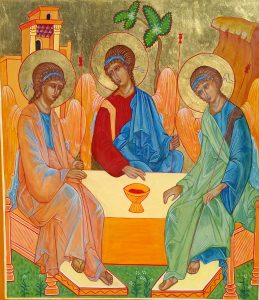Skip to content
Introduction
It is by prayer to the Holy Spirit, in a process of careful and lengthy preparation, that the icon painter begins the work of representing in visible form things that are eternal and unseen.
After this interior preparation the icon board is then made ready. The recessed part of the wood represents the Ark of the Covenant, the holy place which contains the image. A linen cloth is placed around the wood representing the Shroud of Christ and whiting is glued to the surface. The dead wood now takes on a new life.
The image is etched onto the board and earth colours are introduced. Red is used for martyrs, green signifies concern for the spiritual illumination of mankind, and blue signifies a desire for interior prayer.
Icons deliberately avoid a realistic, natural look; they symbolize the transfigured, resurrected body of Christ and the saints. The glorified body, as St Paul says in Corinthians, is not like the earthly body; it is a ‘spiritual body’ (i Cor. 15: 44). In this respect, icons may appear ‘unnatural’, but if the appearance is unnatural to us, we are reminded that in God the order of nature is overthrown: the bush burned, but was not consumed; Israel passed through the Red Sea, but the sea remained impassable; the Virgin gave birth, but remained a virgin.
The finished icon is covered in olifa, an oil used to protect it and bring out its colours. It is then blessed and placed on the altar, where it assumes its role as a channel of divine grace between heaven and earth.
The icon is truly a window into heaven.


